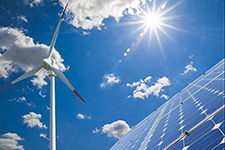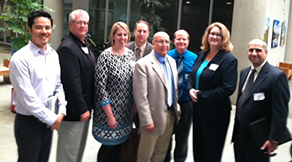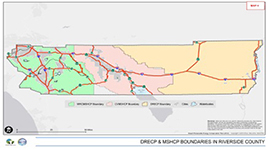|
In July 2014, the County of Riverside initiated the eRED Planning program funded by a grant from the California Energy Commission. The purpose of the eRED program is to coordinate and encourage eligible renewable energy resource development (eRED) in the county at the General Plan level. The two-year grant program will support the County in proposing a General Plan Amendment designed to provide a robust framework of policies and data addressing renewable energy resources throughout the county, particularly supporting the development and expansion of geothermal resources in the Salton Sea region, where feasible, and the coordination of solar resources in the far eastern desert portion of the county in conjunction with the State of California's ongoing Desert Renewable Energy Conservation Plan (DRECP) development. |
 |
 |
Riverside County eRED Team |
With its varied terrain and 200-mile stretch of communities spanning from the Los Angeles metropolis in the west to the Arizona border in the east, the County of Riverside boasts commercially viable renewable energy resources in virtually all categories: wind, solar, geothermal and biomass. Utilizing this broad spectrum of renewable resources, the County is already home to over 4,000 wind turbines generating electricity at 21 commercial wind farms in the San Gorgonio Pass area, four large-scale commercial solar facilities in the eastern desert region, six hydroelectric facilities, three biogas/fuel cell facilities associated with wastewater treatment plants and six biomass facilities utilizing landfill methane capture and operated by the County directly. The Riverside County General Plan encourages the development and siting of renewable energy facilities and transmission lines in appropriate locations, and the development of solar, wind, biomass and geothermal resources in an environmentally responsible and sensitive manner. However, as renewable energy development trends and technologies advance, the County's General Plan must evolve as well to ensure it remains a suitable instrument for guiding county growth throughout the 21st Century. A balanced approach to energy production in Riverside County will ensure that growth and economic prosperity in the region is achieved in a sustainable and environmentally sensitive manner that benefits both local communities and the greater good of our state and our natural world.
For a more detailed look at Renewable Energy Resources within the County of Riverside, visit:
The County eRED project will contribute to a number of County energy policy goals:
| ● | Facilitate renewable energy development in Riverside County. |
| ● | Contribute to California’s long-term renewable energy and greenhouse gas reduction goals. |
| ● | Streamline the permitting process for eligible renewable energy projects in the county. |
| ● | Coordinate the Riverside County General Plan with the policies and plans of the State's DRECP. |
| ● | Ensure protection of desert ecosystems and further Salton Sea restoration plans through the addition of appropriate conservation policies and plans in the County General Plan. |
A major component of this project is the preparation of maps and data addressing the potential for development of eligible renewable energy projects in Riverside County. To accommodate this purpose, the link below leads to a variety of maps and plans, sorted according to region. Some are from State, federal or other sources, some are from the Riverside County General Plan and others have been prepared specifically for this project. Additional maps and analyses will be added as they are pre-pared. Click HERE to go to the Maps and Data page to view a variety of maps and eRED project data, including the Far Eastern Desert and Salton Sea regions, as well as countywide planning information.
 |
 |
|
| Salton Sea | Countywide Planning | Far Eastern Desert |
Key planning and coordination efforts to chart out county policies and plans for renewable energy development within the Salton Sea region will be conducted by the County in close coordination with the Salton Sea Authority. The SSA will provide technical expertise related to planning, engineering and other technical work performed or in-progress to address the Salton Sea region to ensure work efforts are directed to the most suitable and needed lines of inquiry. With its history of cooperation with a number of federal and state partners, including the Bureau of Reclamation, EPA, Fish and Wildlife Service, USGS, California Resources Agency, and many others, the SSA will also provide valuable coordination and contact opportunities between the various entities with whom the County will be seeking to coordinate its renewable energy development planning efforts for the region. In addition, the SSA has also engaged a number of independent contractors to assist in technical and engineering work needed for the region. The close coordination the SSA provides will ensure that work efforts are focused where most needed and do not duplicate others’ efforts. As a separate agency, none of the SSA's work efforts will be funded by the County’s CEC eRED grant.
The DRECP is focused on the desert regions and adjacent lands of seven California counties – Imperial, Inyo, Kern Los Angeles, Riverside, San Bernardino and San Diego. It is being prepared through an unprecedented collaborative effort between the California Energy Commission, California Department of Fish and Wildlife, the U.S. Bureau of Land Management and the U.S. Fish and Wildlife Service; these agencies collectively form the DRECP’s "Renewable Energy Action Team."
The DRECP will result in an efficient and effective biological mitigation and conservation program providing renewable energy project developers with permit timing and cost certainty under the federal and California Endangered Species Acts, while at the same time preserving, restoring and enhancing natural communities and related ecosystems. A total of approximately 22.5 million acres of federal and non-federal California desert lands are in the DRECP Plan Area, including a total of 2,147,000 acres within Riverside County (including 1,846,000 on federal lands).
Some of the documents and other contents presented on this website were prepared as a result of work sponsored by the California Energy Commission. These works do not necessarily represent the views of the Energy Commission, its employees, or the State of California. The Energy Commission, the State of California, its employees, contractors, and subcontractors make no warranty, express or implied, and assume no legal liability for the information in these documents; nor does any party represent that the use of this information will not infringe upon privately owned rights.

